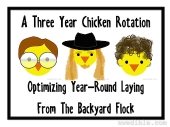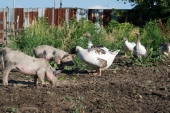posted 13 years ago
Here are a few more thoughts that might be helpful:
I'm upgrading to a 20'x20' hoopcoop out of PVC and field fencing - similar to the dome structure linked to above (which is really neat, by the way), but a larger, stationary hoophouse shape to accommodate mating and brooding spaces, as well as leaving town once in a while. It will have the advantage of being low against the wind in winter (6' at center line), and easy to open up in the summer for maximum air and sun. Because we get all our Southern Oregon rainfall during the chilly months, ventilation is supremely important. A tight, dark, moist coop creates a sickening environment. Conversely, proper humidity promotes a fertile deep litter system, teaming with bugs and sprouts to eat during the lean winter months. I've seen open-air and tarp covered winter coops at 4000' near Grizzly Peak, it's fine here. Our hoopcoop is also cheap enough that I can build one on the south side of our ridge for winter, and one on the north side for summer. I hope that having two coops will save us from trashing our soil in one place. I haven't explored tractor solutions because I don't like rendering chickens flightless, the quality of their breathing is intimately connected to their wing movement - guess that's not such a big deal with meat birds since they don't live long anyway.
Our hawk population is light due to a healthy crow presence. Still, I've found that ranging the birds mostly in the woods, and propping up strips of that cheap, lightweight bird netting helps deter airborne attacks. Also, if you're aware of particular snags that hawks survey a pasture from, you can orient your electric netting to run narrow to the snag, preventing the hawk from having a good trajectory for swooping. Our turkeys are excellent hawk alarms, as are our 5 roosters - I can't imagine ranging hens without awesome roosters. Having electric fencing and a roving dog has deterred ground predation (fox, bobcat, cougar, bear, and marauding dogs). Pastured poultry in this region also tend to survive longer when their set-up is closer to the home rather than out in the back 40.









 1
1




 1
1
















 1
1























